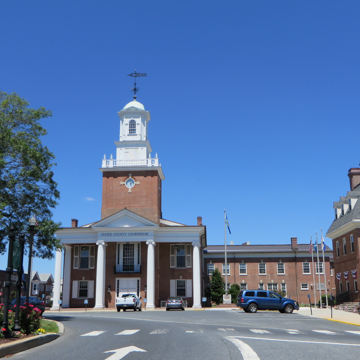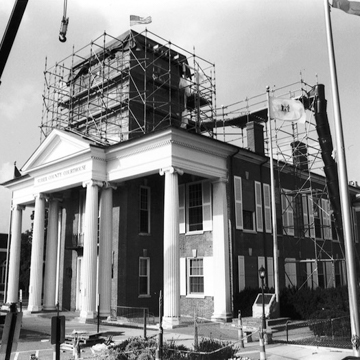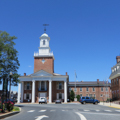A lottery was authorized in 1835 for a new courthouse to occupy the site of the frame original (ES9). Famous Philadelphia architect William Strickland, then at work on the Delaware Breakwater (ES25), charged $60 for what he called “a convenient plan.” Fireproof offices lay below the big courtroom upstairs, with outside of the latter an “Iron Gallery . . . for the use of the Cryer of the Court … declaiming to a multitude beneath” (Gilchrist, 1954). With its Palladian window, Flemish-bond brick-work, and rubbed-and-gauged lintels (bricks shaped for a tight fit and rubbed to bring out their inner warm color), the two-story building clung to the old-fashioned Federal style as opposed to the newer Greek Revival. This was an economy measure; Strickland fretted in his letter of March 1837 to the commissioners: “If I have not been so happy in the front—your limits as to funds are the cause of the Brick Appearance, and I could have wished to have introduced a few columns and some other decorations, on the exterior but was afraid on account of the smallness of the sum to be appropriated.” Two-story Ionic columns with a pediment over the central bay were added nearly eighty years later, along with a much larger tower. Crowds gathered in the courthouse yard for public whippings (until 1906) and hangings (until 1926). The wooden portico was reconstructed in 1969–1970. The state purchased the building in 1994, and its cupola was removed by crane nine years later for refurbishing.
You are here
Sussex County Courthouse
1837–1839, William Strickland, with Joshua S. Layton and Caleb B. Sipple. 1914 portico and tower. 1969–1970 addition. The Circle
If SAH Archipedia has been useful to you, please consider supporting it.
SAH Archipedia tells the story of the United States through its buildings, landscapes, and cities. This freely available resource empowers the public with authoritative knowledge that deepens their understanding and appreciation of the built environment. But the Society of Architectural Historians, which created SAH Archipedia with University of Virginia Press, needs your support to maintain the high-caliber research, writing, photography, cartography, editing, design, and programming that make SAH Archipedia a trusted online resource available to all who value the history of place, heritage tourism, and learning.


















